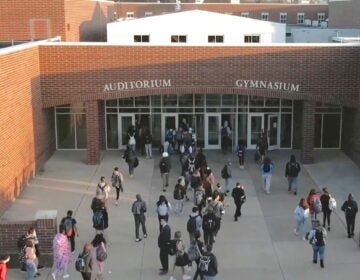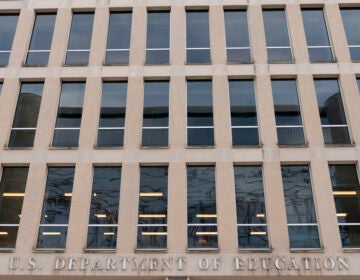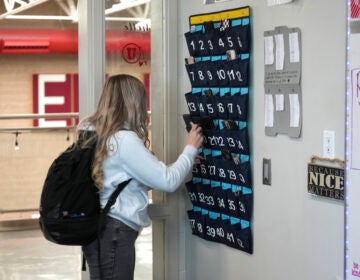Trump administration wants time limits on student visas
There is no set time limit for how long students who come to the U.S. for college can stay. The Trump administration says that is a problem.
Listen 1:30
Haverford College in Haverford, Pa., Wednesday, May 22, 2019. (AP Photo/Matt Rourke)
President Trump has lamented that international students who come to the U.S. for college do not stay, saying, “We want these exceptional students and workers to stay, and flourish, and thrive in America.”
But the Department of Homeland Security now wants to change the visa rules, in a way that critics say would make it more burdensome and expensive for international students to stay in the country.
Right now, international students who come to the U.S. for college can stay as long as they need to finish their degree. That makes it possible for them to go on to graduate school, or take an extra year to do a second major. As long as students do not violate the terms of their visa and keep working on their degree, the government does not care how long they stay.
Rachel Banks, senior director of public policy at NAFSA, a nonprofit international education association, compares it to buying a ticket for the movie theatre: a ticket gets you in, “then frankly nobody cares once you’re in the theater whether you’ve got that valid ticket, the only time that they care is when you walk out of the theatre, go past the ticket taker for any reason … and you want to come back in.”
Similarly, student visas come with an expiration date, but that date indicates when a student can no longer use that visa to go back into the U.S. It does not mean a student has to leave the country by that date.
The Department of Homeland Security now says that is a problem. It wants to start setting definite start and end dates for how long students can stay. It says that would crack down students who stay in the U.S. after finishing their studies and have not gotten a visa extension or switched to a different type of visa. The department says it plans to have a proposed rule out this month.
Miriam Feldblum, executive director of the Presidents’ Alliance on Higher Education and Immigration, says the current system makes sense and does not need such a drastic rule change. Her organization represents hundreds of university presidents across the U.S., including the University of Pennsylvania and Drexel University.
“It’s going to increase uncertainty for students and campuses, it’s going to increase the bureaucratic work of both the agency and institutions … it’s a solution in search of a problem,” she said.
Feldblum argues that if the department uses definite start and end dates, students and school administrators will have to re-apply and pay to extend their visas, when the current, flexible system works and there are not that many students who overstay their visas anyway.
Peter Spiro agrees. He specializes in immigration law at Temple University.
“It’s not an imagined problem. The question is what kind of balance one wants to set … between the very dramatic benefit of having an international student population, versus a real, but not serious, problem of student visa overstayers or visa violators.”
Spiro, other immigration lawyers and advocates, question if the U.S. government should really be adding to the administrative hoops students have to jump through, given that international student enrollment has already gone down since 2017, and that international students contribute billions of dollars to the U.S. economy.
“This is all … with respect to the Trump administration using administrative discretion to clamp down, not just on illegal immigration, but legal immigration as well. The Trump administration is trying to pull out all the stops,” Spiro said.
The public affairs officer for ICE was not available for an interview, but a representative referred to annual reports on the number of people who overstay their visas to the U.S., to explain why the department wants to change the rules. The 2018 report estimates that around 68,000 people on student or exchange visitors overstayed (roughly 3.7 percent of the people who are supposed to have left), compared to around 390,000 people who overstayed on business or tourist visas (roughly 1 percent of the people who are supposed to have left).
Robert Warren, a demographer who used to work for the Census Bureau and Immigration and Naturalization Service (INS), has published research questioning whether the Department of Homeland Security overestimates the number of people who overstay their visas.
This is not the Trump administration’s only attempt to change student visa rules. Back in 2018, U.S. Citizenship and Immigration Services put out a policy memo changing how it would calculate whether students are “unlawfully present” in the country. Unlawful presence used to start whenever USCIS or an immigration judge declared it to a student. The policy memo would remove that requirement, so a student could be found “unlawfully present” without knowing about it.
Haverford College and some other universities sued, and earlier this month, a U.S. District Court judge in North Carolina issued a nationwide injunction against the USCIS memo.
However, Spiro warns that the U.S. Supreme Court has said it does not like nationwide injunctions. For example, the court recently allowed the Trump administration to move forward with plans to deny green cards to immigrants who would be likely to use public benefits, despite injunctions from lower courts. Justice Neil Gorsuch wrote that “the routine issuance of universal injunctions is patently unworkable, sowing chaos for litigants, the government, courts, and all those affected by these conflicting decisions.”
WHYY is your source for fact-based, in-depth journalism and information. As a nonprofit organization, we rely on financial support from readers like you. Please give today.





